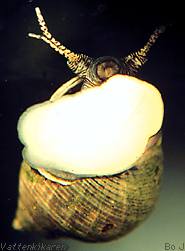Shellfish,
mussels
and barnacles
are examples of organisms that use rigid and hard material in their
shells. They use perianth that is hard and rigid, but is also heavy
and brittle, therefore the perianth is usually mixed with different
organic compounds, for example proteins and polysackarides. These
compounds make the shell lighter and tough.
Flexible material, can be composed of a mixture of different
organic compounds and is used by many algae,
hydroids and anemones.
Even small waves can make these organisms bend and change shape, but
their flexibility prevents them from being injured. Because they can
change their form, there is less risk of them being torn lose from
the rocks. This is because the currents give the organism such a form
that has so little resistance against the water as possible.
To not be washed away, many organisms are permanently
attached to the rocks since they were very young. Examples of such
organisms are seaweed,
Pomatoceros
triqueter and Clavelina
lepadiformis. Other organisms make sure they have a strong
anchor that they can release when they want to move. |

Blue mussels for example can cut their byssus
threads when they want to crawl away with the aid of their food.
When they arrive at their new site, they can build a new and safe
anchor. Most shellfish have the ability to crawl around, even if
somewhat slow. The organ they use to move is known as a foot and
is very large in relation to their body size and enables them to
attach to the bottom very well. In spite of this ability, they often
look for sheltered micro-environments such as cracks and crevices
to inhabit.
Shore
crabs move much quicker than shellfish, but their ability to
attach to rocks and cliffs is poor. The only way they can prevent
themselves from being washed away is to take cover in different
nooks and crannies.
|


